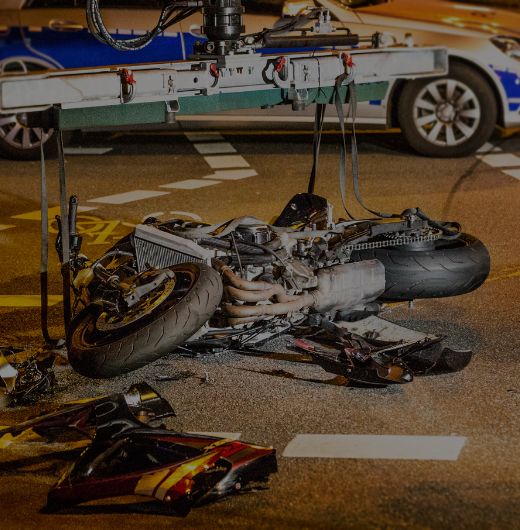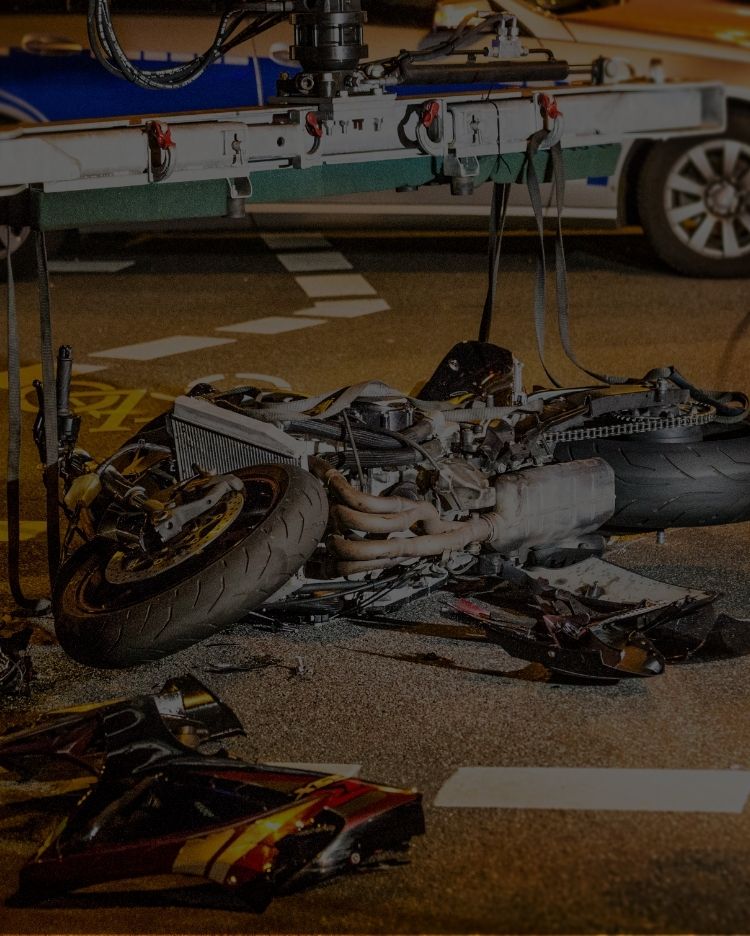Motorcycle accidents are commonly caused by left-turn collisions, rear-end crashes, lane-splitting, and distracted driving. Weather and poor visibility can also contribute to accidents.
Motorcycle accidents refer to collisions involving motorcycles, often resulting in serious injuries due to the lack of protection for riders. Common types include left-turn accidents, rear-end collisions, and crashes caused by weather or distracted driving.
6 Common Motorcycle Accidents & How to Avoid Them
Motorcycle accidents are among the most devastating types of motor vehicle accidents, especially in Hamilton, where challenging road conditions and heavy traffic pose significant risks to riders. Motorcyclists are far more vulnerable than drivers of other vehicles due to the lack of physical protection, increasing the likelihood of serious injury.
Many victims of motorcycle accidents in Hamilton suffer catastrophic injuries such as spinal cord damage, traumatic brain injuries, and other severe conditions. These types of injuries often require extensive medical treatment and long-term rehabilitation, deeply affecting the victim’s quality of life.
Understanding the common causes of motorcycle accidents and taking proactive steps to avoid them can significantly reduce the risk of a crash. If you or a loved one is involved in a motorcycle accident, a Hamilton motorcycle accident lawyer can help protect your rights and ensure you receive the compensation necessary to recover and rebuild.
1. Left-Turn Accidents
Left-turn accidents are among the most common motorcycle accidents. These crashes typically happen when a car or truck makes a left turn in front of a motorcyclist, who either doesn’t have time to react or is in the vehicle’s blind spot. Motorcyclists are especially at risk in these scenarios, as their bikes are smaller and less noticeable, especially at busy intersections.
Why Left-Turn Accidents Happen
- Misjudging Speed and Distance: Drivers often underestimate how fast oncoming vehicles are traveling, particularly motorcycles or smaller vehicles. This leads to turning too early — directly into the path of the approaching vehicle.
- Failing to Yield the Right of Way: Under Ontario law, a vehicle turning left at an intersection must yield to oncoming traffic. Many drivers mistakenly assume the approaching vehicle will slow down or stop — violating the right of way.
- Obstructed View / Limited Line of Sight: Left-turning drivers may have blocked visibility due to other vehicles, especially when turning across multiple lanes or through a line of waiting cars — leading them to make blind or rushed decisions.
- Inattention or Distraction: Distraction (e.g., texting, talking, GPS use) causes drivers to miss the presence of oncoming vehicles, resulting in unsafe or delayed reactions during the turn.
- Rushing Through a Yellow or Stale Green Light: Some drivers attempt to “beat the light” by turning left quickly at the end of a green cycle, miscalculating timing and turning directly into a live lane of oncoming traffic.
- Poor Weather or Night Driving Conditions: In rain, fog, or low light, a left-turning driver may fail to see oncoming headlights or misread road conditions, resulting in unsafe maneuvers.
- Overconfidence or Assumption of Safety: Some drivers turn left on “muscle memory” — relying on habit or prior gaps rather than assessing the current situation. This leads to risky, presumptive turns without properly checking all lanes.
How to Prevent Left-Turn Motorcycle Accidents
- Position Yourself for Visibility: Position your bike where other drivers can clearly see you. Use your headlights during the day to ensure you’re more visible.
- Approach Intersections Cautiously: Always assume that a vehicle may turn in front of you, even if you have the green light. Be prepared to stop if needed.
- Be Alert to Other Drivers: Watch for vehicles that may be in a hurry or distracted. Be extra cautious when drivers appear not to be paying attention.


2. Rear-End Collisions
Rear-end collisions are common in motorcycle accidents, especially when a driver doesn’t notice a motorcyclist in front of them or fails to stop in time. These accidents often result in severe injuries, such as broken bones, spinal cord injuries, and brain injuries, due to the lack of protection for motorcyclists.
Why Rear-End Motorcycle Accidents Happen
- Tailgating: Drivers who follow too closely behind a motorcyclist don’t have enough time to react if the motorcyclist stops suddenly.
- Distracted Drivers: Drivers texting or not paying attention may fail to notice when traffic ahead slows down or stops.
- Motorcyclist Braking Suddenly: In some cases, a motorcyclist may have to brake abruptly to avoid a hazard, catching the driver behind them off guard.
How to Prevent Rear-End Motorcycle Crashes
- Maintain a Safe Following Distance: Always keep a safe distance between you and the vehicle ahead. This gives you more time to react if you need to stop.
- Signal Early: Use your turn signals well in advance to alert other drivers of your intentions.
- Avoid Sudden Braking: When possible, avoid sudden braking. Gradual deceleration allows vehicles behind you to respond appropriately.
- Monitor Rear Traffic: Regularly check your mirrors to be aware of vehicles following too closely.
3. Lane-Splitting Accidents
Lane-splitting occurs when a motorcyclist rides between lanes of traffic, often in slow-moving or stopped traffic. While it can be tempting to bypass heavy traffic, lane-splitting is dangerous. Other drivers may not expect a motorcycle to pass them in such tight spaces, making it easy for a crash to occur.
Why Lane-Splitting Motorcycle Accidents Happen
- Reduced Space: Motorcycles in traffic have less room to maneuver, making collisions more likely.
- Unexpected Lane Changes: Drivers may change lanes without checking their blind spots, unaware of a motorcyclist passing between lanes.
- Increased Risk of Contact: The closer proximity of vehicles increases the chance of contact with another vehicle or road hazard.
How to Avoid Lane-Splitting Accidents
- Refrain from Lane-Splitting: In many places, lane-splitting is either illegal or highly dangerous. If it’s allowed, only do it when conditions are safe and legal.
- Pass Safely: Always pass vehicles when there’s enough space, and never assume that other drivers will make room for you.
- Be Cautious in Heavy Traffic: Don’t try to rush through traffic. It’s better to be patient than to risk a dangerous situation.
4. Intersection Accidents
Intersections are common locations for motorcycle crashes. Motorcyclists often get into accidents when other drivers fail to notice them or misjudge their speed and distance. This is especially true when motorcyclists are riding at higher speeds or approaching the intersection quickly.
Why Motorcycle Accidents Happen at Intersections
- Poor Visibility: Motorcycles can be hard to see at intersections, especially if they’re behind other vehicles or in a driver’s blind spot.
- Right-of-Way Confusion: Drivers may misinterpret the right of way and fail to yield to motorcyclists.
- Speeding: A motorcyclist approaching an intersection at high speed may be difficult for a driver to spot or judge.
How to Prevent Motorcycle Accidents at Intersections
- Approach Intersections Carefully: Slow down and always be prepared to stop, even if you have the right of way.
- Make Yourself Seen: Ensure that you’re visible to other drivers, particularly at busy or poorly-lit intersections.
- Be Aware of Turning Vehicles: Watch for drivers making left or right turns, and be ready to stop or slow down if necessary.
5. Weather-Related Motorcycle Crashes
Weather conditions like rain, snow, or fog can make motorcycle riding especially dangerous. Wet or icy roads reduce traction, while poor visibility increases the chances of a motorcycle crash. Weather-related accidents can lead to injuries that require extensive medical treatment and even long-term care.
Why Weather Affects Motorcycle Accidents
- Slippery Roads: Rain, snow, and ice create slippery surfaces, making it harder for motorcycles to maintain control, especially when turning or stopping.
- Reduced Visibility: Fog, rain, or snow can limit how far you can see, increasing the likelihood of collisions.
- Increased Stopping Distance: Wet or icy conditions increase stopping distances, making it harder to avoid accidents.
How to Prevent Weather-Related Motorcycle Accidents
- Avoid Riding in Poor Weather: If possible, avoid riding when there’s heavy rain, fog, or snow. If you must ride, reduce your speed significantly.
- Increase Following Distance: Allow more distance between your motorcycle and other vehicles. This will give you more time to react in hazardous conditions.
- Wear Proper Gear: Waterproof gear can keep you dry and visible, while protective clothing can help in case of a crash.
- Be Extra Cautious: When riding in adverse conditions, be cautious on turns, intersections, and when approaching stoplights.
6. Distracted Driving Accidents Involving Motorcycles
Distracted driving is a leading cause of motorcycle crashes. Drivers who are texting, talking on the phone, or otherwise not paying attention may fail to see a motorcyclist in their path, leading to serious accidents. Distracted driving can result in motorcycle accident injuries that range from minor to catastrophic.
Why Distracted Driving Causes Motorcycle Accidents
- Inattention: Drivers who are distracted by their phones or other activities are less likely to notice a motorcyclist on the road.
- Failure to See the Motorcyclist: Drivers may not spot a motorcycle in time, especially when they’re in a blind spot or approaching quickly.
- Delayed Reactions: A distracted driver’s delayed response to a motorcyclist in their path can lead to a crash.
How to Avoid Accidents Caused by Distracted Driving
- Stay Visible: Make sure other drivers can see you, especially when you’re in their blind spots.
- Defensive Riding: Be alert and assume that drivers might not be paying attention. Always anticipate their actions.
- Be Aware of Aggressive Driving: If you notice a driver acting erratically, keep your distance and stay cautious.
- compensation you deserve.
Motorcycle Accident Claims and Compensation
After a serious motorcycle crash, the road to recovery can feel overwhelming — physically, emotionally, and financially. The losses you face often extend far beyond the initial impact, affecting your ability to work, care for your family, and enjoy life as you once did. Our Hamilton Motorcycle Accident Lawyers understand what’s at stake. We work tirelessly to recover full and fair compensation for injured riders, ensuring that every aspect of your loss — from medical expenses to future care needs — is properly accounted for. Below are several types of compensation (not all) that may be available in most cases.
-
Pain and Suffering: Compensation for physical pain, emotional distress, and loss of enjoyment of life caused by the accident.
-
Loss of Income and Earning Capacity: Compensation for wages lost due to time off work, and future income loss if you can no longer work or earn at the same level.
-
Out-of-Pocket Expenses: Reimbursement for costs like medications, mobility aids, assistive devices, travel to medical appointments, and home modifications.
-
Future Care Costs: Compensation for ongoing medical care, rehabilitation, therapy, surgeries, or attendant care required due to your injuries.
-
Housekeeping and Home Maintenance: Compensation if you’re unable to perform routine household tasks and need to hire help.
-
Loss of Competitive Advantage: Compensation if your injuries limit your ability to compete in the job market or pursue advancement opportunities.
-
Family Law Act Claims: Family members (such as spouses, children, or parents) may be entitled to compensation for the loss of care, guidance, and companionship
I was referred to Lalande Lawyers by a friend who had previously worked in a professional capacity with Mr. Lalande. He came highly recommended. Mr. Lalande and his team (Ms. Hennessey) were able to help with my LTD denial and I couldn’t be more grateful. I was initially approved for LTD and was engaged and working with the Insurance company when they unexpectedly denied my claim within the year of being approved (despite the strong support from my medical professionals). After reaching out to Mr. Lalande, they reviewed my case and clearly explained the process and potential outcomes. Within just a month of working with Mr. Lalande my LTD benefits were reinstated without question. During a time that was has been difficult and stressful they were able to provide clarity and empathy as well as allowed me to feel more control of my situation, which I appreciate. I highly recommend. – Alanna
Choosing the Right Hamilton Motorcycle Accident Lawyer
Choosing the right legal representation after a motorcycle crash can significantly impact the outcome of your case. Our Hamilton motorcycle accident lawyers know how important it is to find someone you trust — someone with the experience, focus, and commitment to guide you through a difficult time. Here are a few key things to consider when searching for the right lawyer to handle your motorcycle accident claim:
Be Cautious with Advertising: Not every lawyer on a billboard or TV commercial is the right fit for a complex motorcycle accident case. While some advertised lawyers are excellent, others run high-volume practices where your case may be passed off to junior associates or treated like just another file.
Google Reviews: Client reviews can offer helpful insight into how a law firm actually treats its clients. Look beyond star ratings — read the comments to see if people felt heard, supported, and kept in the loop throughout their case.
Experience with Motorcycle Accidents: Motorcycle accident claims aren’t the same as typical car crash cases — they involve different physics, common prejudices against riders, and often more serious injuries. Make sure your lawyer has a solid track record of handling motorcycle claims and understands the medical, legal, and evidentiary nuances involved.
Results and Reputation: Check whether the lawyer has obtained meaningful results in past cases and is respected in their field. Trial experience, published decisions, and peer recognition can signal that the lawyer is capable of handling your case if negotiations fail and litigation becomes necessary.
Personal Connection and Communication: You should feel comfortable with your lawyer and confident that they understand what you’re going through. A good motorcycle accident lawyer will take the time to listen, explain your options clearly, and stay responsive throughout your recovery and claim.
Likability: You’ll be working closely with your motorcycle accident lawyer, so it’s important to choose someone you feel comfortable with and can trust to genuinely advocate for you.
Get the Legal Support You Deserve and Call our Hamilton Motorcycle Accident Lawyers Today
If you’ve been seriously injured in a motorcycle accident, securing skilled legal representation is one of the most important steps you can take. Our Hamilton motorcycle accident lawyers have the experience, insight, and dedication to guide you through the legal process, protect your rights, and pursue the full compensation you’re entitled to.
Call us today at 905-333-8888 or fill out our confidential contact form for a free, no-obligation consultation. We’re here to help you understand your options — and to fight for the outcome you deserve.
Article FAQs
To prevent a left-turn accident, always be cautious when approaching intersections, use your headlights for visibility, and avoid assuming that other drivers will see you.
Yes, motorcycle accidents are often more dangerous than car accidents. Motorcyclists are at a higher risk for severe injuries like traumatic brain injuries and spinal cord injuries due to the lack of protection.
After a motorcycle accident, seek medical attention immediately, call the police, gather evidence, and contact a Hamilton motorcycle accident lawyer to discuss your claim.
Common injuries from motorcycle accidents include brain injuries, spinal cord injuries, broken bones, and road rash. Serious accidents can also result in internal injuries and severe trauma.


